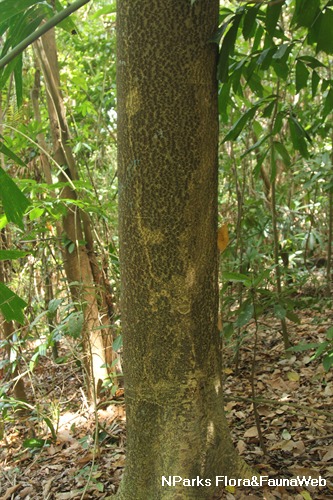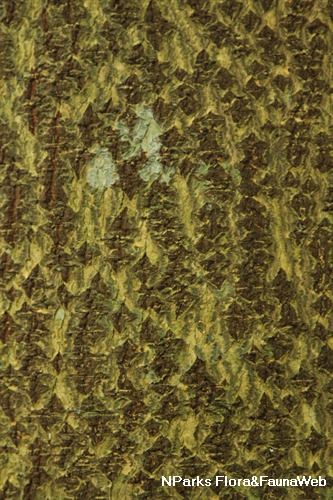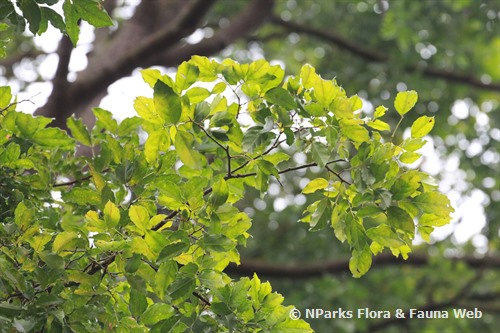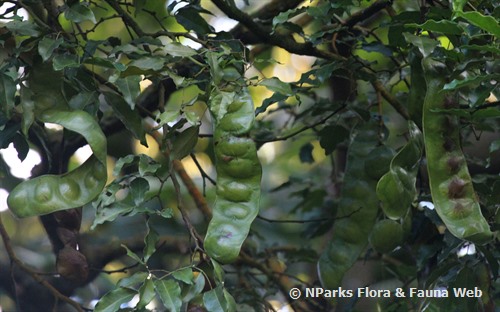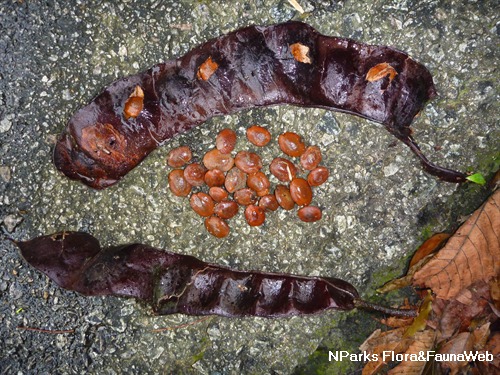
Back
Albizia splendens Miq.
| Family Name: | Fabaceae (Leguminosae) |
| Synonyms: | Pithecellobium splendens (Miq.) Prain, Serialbizzia splendens (Miq.) Kosterm. |
| Common Name: | Keredas, Kungkur, Medang Buaya, Medang Gati, Medang Kok |
Name
Classifications and Characteristics
| Plant Division | Angiosperms (Flowering Seed Plants) (Dicotyledon) |
|---|---|
| Plant Growth Form | Tree (Big (>30m)) |
| Lifespan (in Singapore) | Perennial |
| Mode of Nutrition | Autotrophic |
| Plant Shape | Irregular |
| Maximum Height | 50 m |
Biogeography
| Native Distribution | Peninsular Thailand, Sumatra, Peninsular Malaysia, Singapore, and Borneo |
|---|---|
| Native Habitat | Terrestrial (Primary Rainforest, Secondary Rainforest) |
| Preferred Climate Zone | Tropical |
| Local Conservation Status | Native to Singapore (Endangered (EN)) |
Description and Ethnobotany
| Growth Form | It is a tree up to 50 m tall, without buttresses. The bark is pale yellow-brown to silvery or greyish-brown, and deeply fissured. |
|---|---|
| Foliage | Its alternate, stalkless, bipinnate leaves consist of a pair of side stalks that bear 1–3 pairs of secondary leaflets (pinnules) each. Its opposite, stalked pinnules have rigidly papery blades that are egg-shaped, oval to drop-shaped-oval, unequal-sided, very wavy, and 5.5–17 by 3.5–11 cm. A large gland is found at the junctions of the side stalks, and sometimes between the bases of the terminal leaflets. |
| Flowers | Its stalkless flowers are greenish-white and develop as 5–15 together in flower-heads. These flower-heads are about 2 cm wide, and found in much-branched shoots that are covered with hair, at the leaf axils or at the end of leafy twigs. |
| Fruit | Its indehiscent fruits are slightly twisted pods, flat, black or blackish-brown, and up to 18–30 by 3.5–5 cm. Its brown seeds are irregularly-shaped, 10–14 mm wide, and visible externally. The seed coat is very thick and hard. |
| Habitat | It grows in primary lowland rainforests, old secondary forests, on ridges and steep hillsides, up to 700 m altitude. |
| Associated Fauna | Its flowers are insect-pollinated. |
| Cultivation | It can be propagated by seed. |
| Etymology | Latin albizia, commemorating the Italian botanist of the 18th century, Fidel Albizzi; Latin splendens, splendid, the reference to which is unknown |
| Ethnobotanical Uses | Others: The plant can be cultivated as a park tree. The hardwood is used for making furniture. |
Landscaping Features
| Landscaping | It is suitable for parks. |
|---|---|
| Landscape Uses | Parks & Gardens |
Fauna, Pollination and Dispersal
| Pollination Method(s) | Biotic (Fauna) |
|---|---|
| Seed or Spore Dispersal | Abiotic |
Plant Care and Propagation
| Light Preference | Full Sun, Semi-Shade |
|---|---|
| Water Preference | Moderate Water |
| Plant Growth Rate | Moderate |
| Rootzone Tolerance | Moist Soils, Well-Drained Soils, Fertile Loamy Soils |
| Propagation Method | Seed |
Foliar
| Foliage Retention | Evergreen |
|---|---|
| Mature Foliage Colour(s) | Green |
| Mature Foliage Texture(s) | Papery |
| Foliar Type | Compound (Bipinnate) |
| Foliar Arrangement Along Stem | Alternate |
| Foliar Attachment to Stem | Sessile |
| Foliar Shape(s) | Non-Palm Foliage (Obovate, Oval, Elliptical) |
| Foliar Venation | Pinnate / Net |
| Foliar Margin | Entire - Wavy / Undulate |
Floral (Angiosperm)
| Flower & Plant Sexuality | Bisexual Flowers |
| Flower Colour(s) | Green - Light Green, White |
|---|---|
| Flower Grouping | Cluster / Inflorescence |
| Flower Location | Axillary, Terminal |
Fruit, Seed and Spore
| Mature Fruit Colour(s) | Black, Brown |
|---|---|
| Fruit Classification | Simple Fruit |
| Fruit Type | Dehiscent Dry Fruit , Legume / Pod |
Image Repository
Others
| Master ID | 29210 |
|---|---|
| Species ID | 3519 |
| Flora Disclaimer | The information in this website has been compiled from reliable sources, such as reference works on medicinal plants. It is not a substitute for medical advice or treatment and NParks does not purport to provide any medical advice. Readers should always consult his/her physician before using or consuming a plant for medicinal purposes. |



